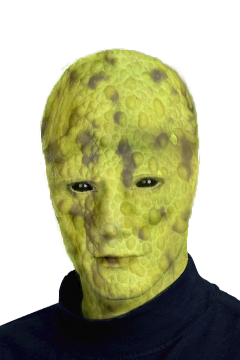User:Chen/Temp Work Page: Difference between revisions
(work on Multispecies Initative data for Budding Species) |
Ashley Roy (talk | contribs) m (Ashley Roy moved page Tallis temp work page to User:User:Chen/Temp Work Page: moving to userspace) |
Revision as of 01:43, 15 April 2015
| Intelligent Lifeform Index |
|---|
| Chen/Temp Work Page | |
|---|---|

| |
| Four Letter Code | BDSP |
| Federation Status | Member |
| Planet of Origin | Unspecified |
| Encountered | DS9: Heart of Stone |
| T/E Rating | T0/E0 |
| Current Tech Level | N+ (Federation Standard) |
| List of Named Chen/Temp Work Pages | |

| |
Full ILI Gallery • Permitted Species Gallery | |
Home System
Homeworld
History
Government
Description
A sentient species which reproduces asexually by budding. Members of the budding species are bald, have black eyes, no external ear lobes and membranous wings that are used to cover the reproductive area on their backs rather than for flight. Their skin is moist and similar to that of a Terran newt, frog or toad, with microscopic pores that absorb oxygen.
As the species has no lungs, speech is achieved by taking in air through narrow slits in the side of the neck. This produces a characteristic sucking noise, as air is drawn over the vocal chords.
Physiology
The budding species are amphibious. Their skin is something like newt or toad skin, with a lot of cracks. There are small, stomatal pores all over their bodies that absorb oxygen from water and the air, and nutrients from water only.
In a similar way to Takarans, they have a distributed physiology. Organelles responsible for breathing, digestion, immune reactions and so forth are in multiple places throughout the body. If one is compromised the others take over.
Respiration, Hydration and Nutrition
This species has no circulatory system or blood - oxygen does not need to be carried around their bodies as the stomatal pores on their skin extract oxygen from the air and (to a lesser extent) from water. Water disperses through their body by diffusion, helping to further oxygenate each life-form. Hydration suits containing mineral nutrients dissolved in water must be worn on the lower half of the body. Pores on this half of the body are designed to extract the minerals from the water slowly. The minerals and water should be replenished once a week.
While mineral nutrients cater for almost all of the life-form's diet, it is supplemented by ingestion of some insect species. These are digested in a pouch in the throat, which bulges if the life-form has eaten too much. This 'stomach' has a semi-permeable layer, which allows nutrients to filter out and disperse throughout the organism.
Their skin is permanently moist and should not be allowed to dry out. To keep them from wetting a ship's consoles and uniforms, gloves are worn, and the inside of the upper half of the uniform is lined with a waterproof fabric layer.
Gender and Reproduction
Members of the budding species are genderless and reproduce through budding. Budding is a form of asexual reproduction where the host effectively produces clones of itself. Budding occurs on a patch on the back between the wings. This should not be covered by a uniform. The cells on that part of the back are effectively stem cells. When the time for budding comes around, the cells respond to hormonal secretions and begin to evolve into larvae, beneath a protective dermal layer. Once they have grown to a sufficient size, they detach from the parent. This part of the process must occur in an enriched breeding pool, as this is the environment in which the larvae will live for the next four to six months. As such, specialised breeding ponds are fitted in the quarters of breeding officers in addition to any existing water/mineral baths to accommodate the young.
The number of offspring in each litter increases each time the parent reproduces. Lieutenant Vilix'pran on Deep Space 9 was recorded as having produced two, then four offspring, and it was noted by its doctor that it could produce anywhere from eight to eighteen young during its third budding.
If the parent is malnourished for any reason, or if it is ill, then they will not reproduce. In addition, they are able to detect hormones of members of their own species. In situations where an environment is overcrowded, this will also curb reproduction and the budding cycle will be skipped.
Members of this species have wings, which are membranous and have evolved to act as a cover for the region of their back where budding occurs rather than being able to take their weight in flight. They remain folded to act as a protective barrier to this sensitive region until larvae are ready to detach from the parent organism.
Common Ailments
Members of the budding species are susceptible to a fungal disease, known as chytridiomycosis. This can seriously affect a member of this species as it can riddle the host's cells with fungal spores. In such cases, the antifungal medication, itraconazol, must be administered.
Psychology
Society
They have no concept of what male and female means, other than what they may have learned from reading it or studying the sociological principles, or meeting members of other species and talking to them about it. (It still feels very alien to them, though, either way). Members of this species refer to each other (and in many cases to all members of other species) using the pronoun 'it'. Those who have made the effort to understand the concept of gender may use other pronouns, although they may not always choose to use the right ones.
Culture
Customs
Technology
Economy
Military
Federation Intelligence Files
The budding species is represented in Starfleet on Deep Space Nine by Ensign Vilix'pran, who is reassigned away from the hazardous materials of Cargo Inspection a month before the buds undergo hatching.